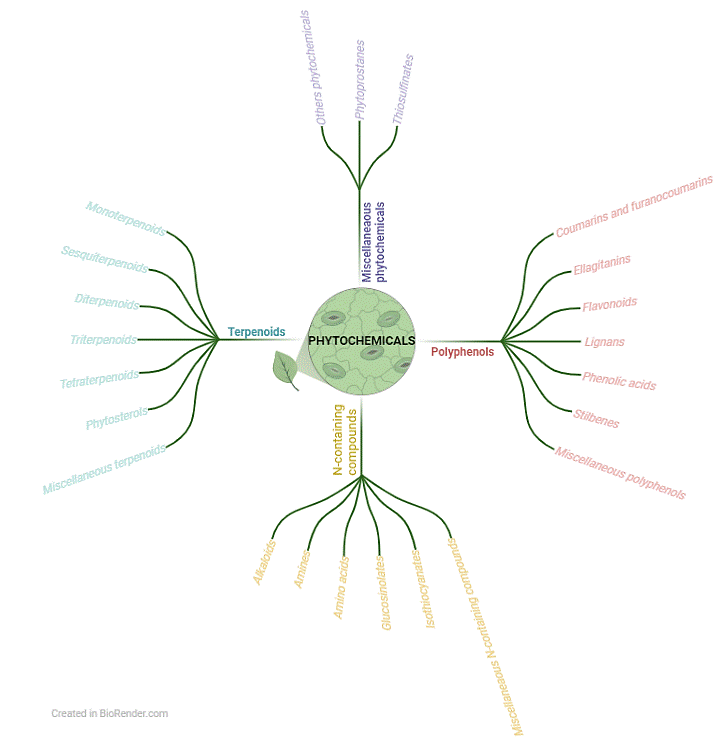Classification of food phytochemicals

French version
Plant secondary metabolites, also called phytochemicals, are compounds that are not essential for plant growth, reproduction or development. However, they provide many benefits to plants: defense against herbivores or infectious microorganisms, protection against UV and extreme weather conditions, communication between plants, attraction of pollinating insects and birds, and many others. They are therefore very important molecules, with unique characteristics. Their chemical structures are very diverse, ranging from a simple skeleton (e.g. thymol) to very complex molecules (e.g. ginsenoside), which are almost impossible to produce in the laboratory.

Their distribution in the plant kingdom also varies. Some phytochemicals are distributed in many plants, while others are very specific to a plant or botanical family that carries the genes needed to make the compound. Finally, each food plant contains a unique combination of several dozen or even hundreds of phytochemicals. In total, it is estimated that 1,500 to 2,000 phytochemicals are present in our diet. The PhytoHub database has so far inventoried more than 1,350 food phytochemicals. A classification was established in order to find our way through this complexity of molecules. Three main classes of food phytochemicals have been defined:

- Polyphenols, which represent a very large family of molecules, some of which are present in many foods: red fruits, citrus fruits, tea, coffee, cocoa... Several subfamilies are found: flavonoids, lignans, ellagitanins, coumarins, phenolic acids, stilbenes. Polyphenols initially aroused a lot of interest because of their chemical structure conferring them some antioxidant capacities. But we know today that many of them can exert various other biological activities that are responsible for their beneficial role in preventing chronic diseases such as cardiovascular diseases.
- Terpenes represent the second major family of phytochemicals. They are divided into subfamilies according to the number of carbon atoms present in the molecule: monoterpenes (10 carbons), sesquiterpenes (15 carbons), diterpenes (20 carbons), triterpenes (30 carbons) and tetraterpenes, among which we find the carotenoids (40 carbons). Monoterpenes and sesquiterpenes are the components of essential oils at the origin of their characteristic odour. Examples include the smell of citrus fruits or aromatic herbs such as rosemary or thyme. Carotenoids are responsible for the orange or red color of some of our foods (carrots, tomatoes...), and some of them can be transformed into Vitamin A in humans.
- Nitrogen-containing compounds form a family at the origin of many drugs of powerful therapeutic interest (e.g. morphine), but also containing compounds with milder nutritional effects. This category of molecules is characterized by the presence of one or more nitrogen atoms in the chemical structure. There are subfamilies: alkaloids, glucosinolates, isothiocyanates, amines and amino acids. Among the best-known alkaloids, we find caffeine, which is well known for its stimulating properties of the cardiovascular system and the nervous system. Glucosinolates, present in the Brassicaceae family (cabbage, broccoli, mustard), have anti-inflammatory activities and are responsible for the pungent flavor of these foods. In addition, these compounds are being studied for their preventive effect on certain cancers.
Beyong polyphenols, terpenes and Nitrogen-containing compounds, there are many other compounds that belong to smaller families of phytochemicals (e.g. phytoprostanes, or thiosulfinates).
Because of their high bioactivity, phytochemicals are currently the subject of much research to decipher their effects on human health. Some are now well evaluated, but others are still poorly studied and the mechanisms by which they act remain to be elucidated in most cases.
For more information:
- PhytoHub. Available on: https://phytohub.eu/
- Wu J, Cui S, Liu J, Tang X, Zhao J, Zhang H, et al. The recent advances of glucosinolates and their metabolites: Metabolism, physiological functions and potential application strategies. Crit Rev Food Sci Nutr. 7 avr 2022;0(0):1‑18.
